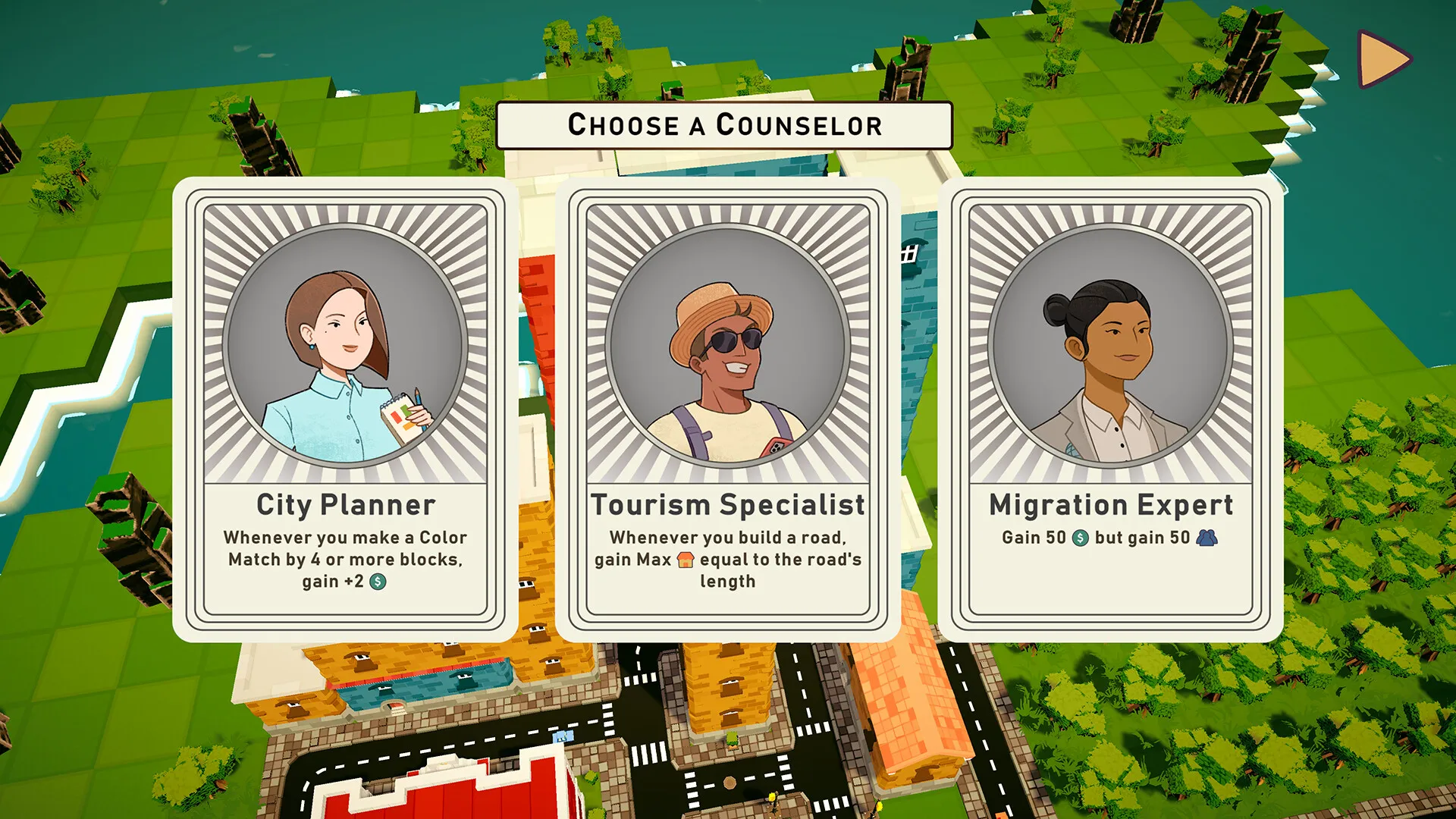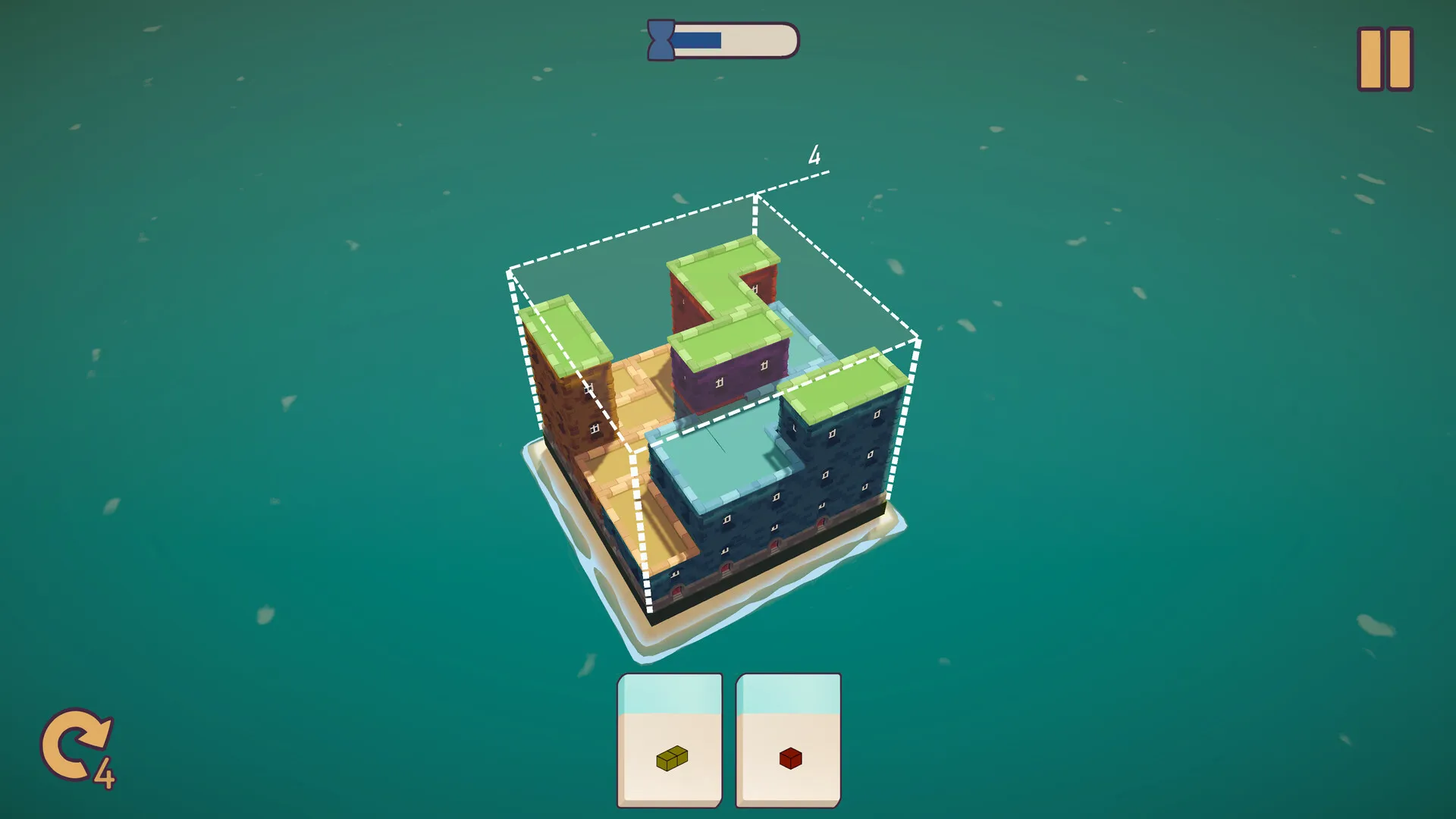Mini City: Mayhem presents a mix of puzzle mechanics and urban planning challenges. The game introduces a system where players assemble structures by positioning a variety of block shapes, reminiscent of classic tile puzzles.
Starting on modest islands, you gradually build up a town that grows with every carefully placed piece. Every block and road placed influences the city’s structure and the pace of progress, requiring a steady rhythm of planning and quick thinking.
Assuming the role of a mayor, you carry the responsibility of shaping the city’s landscape. The game uses a relaxed visual style that complements the tension arising from resource management and spatial constraints. Your decisions about stacking buildings and aligning roads bring a personal touch to the evolving cityscape. The design is simple enough to be approachable, yet it invites thoughtful strategies that impact both layout and gameplay.
Small victories, such as successfully managing limited space, trigger moments of delight, while setbacks in resource allocation can prompt a sense of urgency.
This balance between calm visuals and engaging challenges offers a fresh take on urban construction, leaving you to wonder how every decision contributes to the unfolding narrative of your city. The experience invites reflection on the connection of control and spontaneity that shapes the creative process.
Game Mechanics and Strategic Depth
Mini City: Mayhem introduces a play system that centers on arranging building pieces, each depicted as a block with distinct shapes and sizes. The process of rotating, positioning, and aligning these blocks requires a steady hand and keen observation.
Each block’s placement affects how roads connect the various parts of your emerging city, and the challenge increases when specific pieces must be set on ground level or atop higher floors. The spatial challenge here means that even a small misstep can disrupt your intended layout, engaging both your problem-solving skills and spatial awareness.
The game employs a dual resource system that challenges you to manage funds and gather Experience Points (XP) simultaneously.
Your cash accumulates at a slow pace, echoing the gradual progression found in incremental games. This steady income forces you to think carefully about when to invest in new blocks and when to hold back.
In tandem, XP functions as a metric for progress, with strategic placements—such as aligning blocks of matching colors—resulting in noticeable boosts.
An additional layer of urgency is provided by the Maximum Population meter, which functions as a timekeeper of sorts. As the meter fills, it reflects the diminishing patience of your virtual residents, adding pressure to your decisions and inviting a careful balance between expansion and efficiency.
Special mechanics further enrich the experience. Rerolls offer a chance to replace an unsatisfactory block, with extra opportunities to reroll available through special in-game structures. This system demands foresight; every placement is permanent, meaning each decision carries weight and can shape your future options.
The array of building types—from residential structures that boost population limits to special buildings that offer tactical benefits—ensures that each choice contributes distinctly to the progress of your city. Road pieces, too, have a vital role in maintaining connectivity, underpinning the practical aspects of urban growth.
The interplay between precise block placement and the management of scarce resources creates moments that are both challenging and emotionally engaging. You may feel a surge of satisfaction when a well-timed move leads to a successful chain reaction of XP gains or when a difficult road connection secures your city’s survival.
Conversely, a single poor decision can disrupt the carefully built structure, evoking a sense of loss and prompting a desire to improve with each subsequent attempt. This combination of mechanical rigor and emotional response fosters a thoughtful reflection on how every decision shapes the unfolding narrative of your urban experiment.
Game Modes and Variants
Mini City: Mayhem presents several gameplay options that significantly change the pace and challenge of building your urban environment. In Campaign Mode, the game is divided into 9 distinct levels set on different islands.
Each level offers its own set of obstacles while you construct your city, aiming to complete a monument as a mark of progress. A system that tracks Experience Points along with specific level goals guides your advancement, turning each island into its own unique project that rewards careful planning and strategic choices.
Switching gears, the Time-Based and Challenge Modes ramp up the pressure. Mayhem Mode introduces a fast-paced test where the dwindling patience of your city’s inhabitants and the steady income of resources demand quick and accurate decisions.
Meanwhile, Square Stack Mode provides a grid-oriented challenge that resembles classic tile puzzles. Here, height limits and the pressure of timed placements require swift adjustments and precise moves, ensuring that each choice has an immediate impact on your progress.
Alternative and Creative Modes add a new dimension to the experience. Crane Mode challenges you with falling blocks from a swinging crane, introducing real-time physics that force you to adjust your strategy on the fly. Zen Mode removes time restrictions, shifting the focus entirely to spatial planning and methodical decision-making.
Finally, Sandbox Mode allows free experimentation with city layouts without any imposed constraints. Each mode offers a distinct rhythm and set of challenges, prompting varied emotional responses and inviting a personal interpretation of urban design, leaving the experience open to ongoing reflection.
Visual and Audio Presentation
Mini City: Mayhem presents an engaging visual setup with a clear isometric style. The artwork uses simple, bright hues and uncluttered designs to depict urban environments that feel familiar yet crafted for playful experimentation.
The cityscapes and maps evoke scenes from well-known urban centers, suggesting a design inspired by recognizable global layouts. This approach makes it easy to read the environment and understand the spatial relationships necessary for building a thriving city.
The interface is designed to be straightforward. A neatly arranged block deck at the bottom of the screen shows available building pieces, while color indicators and brief tooltips assist with placement decisions.
The camera offers a fixed isometric view with rotation controls that allow you to examine your city from different angles. However, as the urban sprawl grows, the fixed perspective sometimes creates moments of uncertainty in identifying available spaces. These instances invite a measured response and careful planning during gameplay.
Sound in the game contributes significantly to the overall atmosphere. A limited selection of background tracks maintains a calm setting throughout each level, setting a relaxed pace that supports steady decision-making.
Sound effects accompanying key actions—such as placing a block or completing a stacking sequence—provide immediate feedback, reinforcing the connection between your choices and their outcomes. While the repetition of these cues may be noticeable over time, they serve as a consistent reminder of your progress.
The combination of clear visual cues and responsive audio feedback creates an experience where each element works together to enhance the challenge of urban planning. The interplay between graphic clarity and sound design invites you to consider how subtle cues can shape your emotional engagement and guide your decisions in building a dynamic city.
Strategic Depth and Gameplay Challenges
Mini City: Mayhem demands careful thought with every block placed on its limited grid. The confined map forces you to plan your city layout efficiently, making every placement carry lasting consequences.
Building upward becomes a practical choice, allowing you to maximize available space while integrating roads that serve both practical and aesthetic functions. A well-considered structure helps maintain order, so your urban area grows in a deliberate and effective manner.
Managing resources plays a central role in this experience. Players must keep a close eye on their funds, progress measured by XP, and the dwindling patience of the residents. The slow accrual of money requires measured spending, while the XP system rewards precise and thoughtful placement of blocks.
An ever-climbing population meter presses you to act with urgency, reminding you that every decision can shift the balance between progress and stagnation. Special Buildings and Councillors provide timely boosts—cash injections and extra capacity among them—that support longer-term plans and help ease the pressure of continuous expansion.
Each placement is permanent, a factor that heightens the need for accuracy and foresight. The color matching of blocks, combined with the order in which they are stacked, introduces extra strategic considerations.
Every move adds a twist to the overall challenge, as the interplay of these elements creates new scenarios in each game mode. Campaign challenges, timed trials, and creative free-form play all offer distinct puzzles that reward meticulous planning and adaptability.
This system of strategic choices invites an ongoing conversation between your actions and the evolving state of your city, prompting reflection on how each decision builds a narrative of its own. The result is an experience that continuously invites you to refine your approach with each play, leaving room for questions about the delicate balance between planning and spontaneity.
Technical Performance and Additional Features
Mini City: Mayhem demonstrates reliable performance on various systems, including those with modest hardware capabilities. The game delivers stable frame rates and responsive controls, enhancing the satisfaction of each building decision.
Available on PC via Steam, it has been designed to run smoothly even during complex building sequences. Although support for devices such as the Steam Deck is not present, there appears to be potential for mobile compatibility in future updates.
The user interface is crafted for ease of use, featuring a clear block deck and straightforward tooltips that guide every placement. The camera system offers rotation controls that allow different views of your construction, yet it occasionally struggles when your city expands significantly. Refining camera fluidity and improving UI clarity could further improve the experience.
A variety of game modes contribute to the session’s flexibility, inviting players to experiment with different strategies and tackle varied challenges. These features, coupled with the simple yet effective mechanics, introduce further dimensions to your experience and encourage repeated play.
The technical setup and additional features work in harmony to create a session that rewards precise planning and creative experimentation, prompting continuous reflection on how every decision shapes your urban landscape.
The Review
Mini City: Mayhem
Mini City: Mayhem blends puzzle mechanics with city-building strategy, offering an experience that is both accessible and challenging. Its block-stacking system rewards careful planning, while varied game modes provide multiple ways to engage with its mechanics. The visual design is functional, though the camera and interface could use refinement. The game runs well, with a relaxing atmosphere that contrasts with its underlying complexity. While it lacks deep narrative elements, its engaging mechanics create a satisfying rhythm of decision-making. For fans of strategic puzzle games, it’s a worthwhile experiment in structured creativity.
PROS
- Unique blend of city-building and puzzle mechanics that encourages strategic thinking.
- Varied game modes cater to different playstyles, from time-based challenges to relaxed sandbox building.
CONS
- Camera control can be frustrating when the city grows larger.
- Repetitive music and sound effects may wear thin over time.




















































